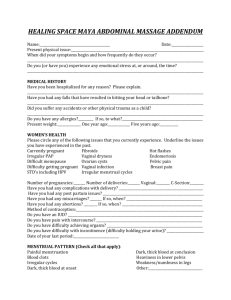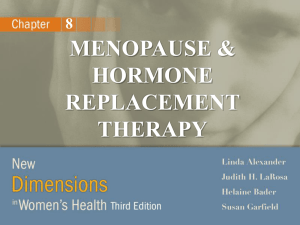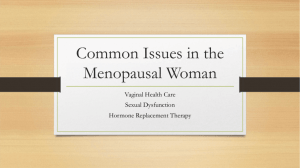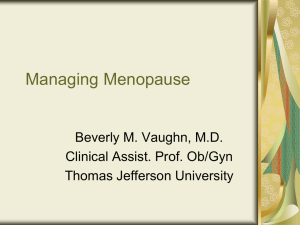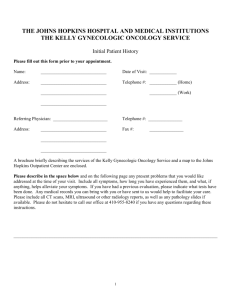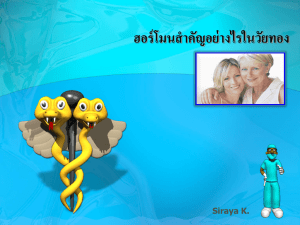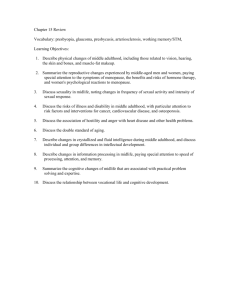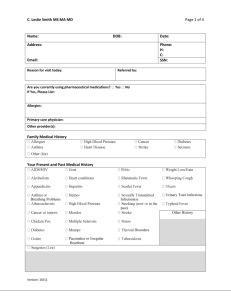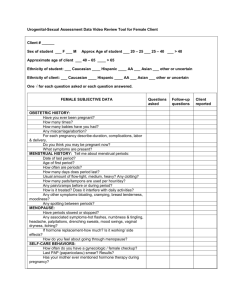Classic symptoms
advertisement
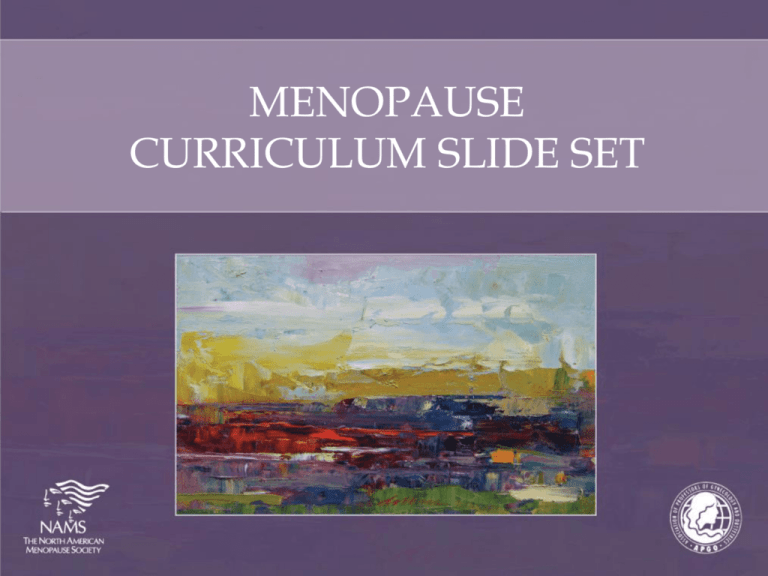
MENOPAUSE CURRICULUM SLIDE SET What is menopause? • Menopause is a normal, natural event, defined as the final menstrual period (FMP), confirmed after 1 year of no menstrual bleeding • Represents the permanent cessation of menses resulting from loss of ovarian follicular function, usually due to aging When is menopause? • Naturally (spontaneously) average age 51 • Prematurely from medical intervention (eg, bilateral oophorectomy, chemotherapy) • At any time from impaired ovarian function Menopausal symptoms & signs Classic symptoms: • Change in menstrual cycle pattern (early) • Vasomotor symptoms (includes night sweats) • Vulvovaginal symptoms, dyspareunia Other symptoms sometimes associated with menopause • Sleep disturbances besides night sweats • Cognitive concerns (memory, concentration) • Psychological symptoms (depression, anxiety, moodiness) Stages of reproductive aging • In 2001, the Stages of Reproductive Aging Workshop (STRAW) established a nomenclature for reproductive aging • In 2010, STRAW + 10 recommended modifications to the model The Stages of Reproductive Aging +10 staging system for reproductive aging in women Terminology: Perimenopause • The time around menopause, also called “the menopause transition” • The most symptomatic phase for women Terminology: Induced menopause • Cessation of menstruation that follows bilateral oophorectomy (with or without hysterectomy) or chemotherapy or pelvic radiation therapy; also iatrogenic menopause Terminology: Premature menopause • Any menopause that occurs before age 40 Terminology: Primary ovarian insufficiency • A continuum of impaired ovarian function leading to amenorrhea in women younger than age 40 Terminology: Postmenopause • The years after the FMP resulting from natural (spontaneous) or premature menopause • With current life expectancy, the postmenopausal years make up 1/3 to 1/2 of the lifespan of most North American women CLINICAL APPROACH TO THE MIDLIFE WOMAN Menstrual bleeding changes Changes in both menstrual flow and frequency are common and usually normal: • Lighter bleeding • Heavier bleeding • Duration of bleeding • Cycle length • Skipped menstrual periods Abnormal uterine bleeding (AUB) AUB is excessive or erratic bleeding: • Heavy menstrual bleeding (avg. blood loss >80 mL), especially with clots • Menstrual bleeding lasting >7 days or ≥2 days longer than usual • Intervals <21 days from the onset of one menstrual period to the onset of the next one • Any spotting or bleeding between periods • Bleeding after sexual intercourse Vasomotor symptoms • Recurrent, transient episodes of flushing accompanied by a sensation of warmth to intense heat on the upper body and face • As many as 75% of perimenopausal women in the US have hot flashes • Triggered by small increases in core body temperature acting within a reduced thermoneutral zone • Treatment based on symptom severity and a woman’s risks and personal attitudes about menopause and medication Hot flash physiology illustration Vaginal symptoms • Symptoms such as vaginal dryness, vulvovaginal irritation/itching, and dyspareunia are experienced by an estimated 10% to 40% of postmenopausal women • Unlike vasomotor symptoms, which abate over time, vaginal atrophy is typically progressive and unlikely to resolve on its own • Treatments include: regular sexual activity, lubricants and moisturizers, and local vaginal estrogen Vaginal atrophy illustration Vaginal atrophy as illustrated by contrast of vaginal epithelium in a well-estrogenized premenopausal state (left panel) with a low-estrogen postmenopausal state (right panel) Sexual health • Sexual issues generally increase with aging; distressing sexual complaints peak during midlife (ages 45-64) and are lowest from age 65 onward • Decreased estrogen causes a decline in vaginal lubrication and elasticity • Decreased testosterone may contribute to a decline in sexual desire and sensation • An active sex life, lubricants and moisturizers, and local vaginal estrogen help maintain vaginal health Don’t forget STI screening • Clinicians should not assume that peri- and postmenopausal women are not at risk for STIs • Vaginal atrophy increases the risk for contracting an STI • Older women may not be as knowledgeable as younger women about infection risks or steps to take to reduce those risks Sleep disturbances • Peri- and postmenopausal women sleep less, have more frequent insomnia, and are more likely to use prescription sleeping aids • Perceived decline in sleep quality may be attributed to: – General aging effects (eg, nocturnal urination) – Sleep-related disorders (eg, apnea) or other illness (eg, chronic pain, depression) – Stress, negative mood – Ovarian hormone changes Sleep disturbances (cont’d) • Hot flashes (night sweats) can trigger awakenings in the first half of the night, but REM in the second half suppresses thermoregulation thus hot flashes • Decisions on whether and how to treat—with behavioral or drug therapy, or both—depend on: – Severity of sleep disturbance – Context of sleep problem (eg, distressing hot flashes or life stress) – Severity of daytime consequences Cognitive changes • Midlife women should be counseled that memory and concentration problems are probably not related to menopause but rather to normal aging and/or mood, stress, or other life circumstances Mood disorders • Feelings of upset, loss of control, irritability, fatigue, and blue moods (dysphoria) at midlife may be caused by fluctuating hormone levels that perturb neural systems transiently • Women with a history of premenstrual syndrome, significant stress, sexual dysfunction, physical inactivity, or hot flashes are more vulnerable to depressive symptoms Mood disorders (cont’d) • The most predictive factor for depression at midlife and beyond is prior history of clinical depression • Relaxation and stress reduction techniques, antidepressants, and counseling or psychotherapy are options to consider in symptom management Urinary symptoms • Urinary complaints are common in midlife women but no link to menopause-related estrogen loss has been identified • Over 50% of women >age 50 with urinary incontinence, also report symptoms of overactive bladder (OAB) • Mild incontinence in early perimenopause tends to decline in the first 5 years after menopause • Weight loss for overweight women is effective • Kegel exercises can cure more than 50% of cases of stress incontinence when performed regularly • Several medications are approved for OAB Osteoporosis • Defined as compromised bone strength • Serious health threat for aging postmenopausal women by increasing risk of fracture • 13%-18% of white American women ≥age 50 have osteoporosis of the hip • Lower estrogen levels account for about 2/3 of bone loss during the 5-7 years around menopause • Definitions based on BMD results: – Normal: T-score greater than or equal to –1.0 – Low bone mass (osteopenia): T-score between –1.0 and –2.5 – Osteoporosis: T-score less than or equal to –2.5 Osteoporosis risk factors Risk factors for osteoporotic fracture used in FRAX 10-year calculator (www.shef.ac.uk/FRAX/tool.jsp) • Advanced age (ages 50-90) • Parental history of fragility fracture • Female sex • Current tobacco smoking • Weight • Long-term use of glucocorticoids • • • • • • Height Rheumatoid arthritis Low femoral neck BMD Prior fragility fracture Alcohol intake >3 units daily* Other causes of secondary osteoporosis *1 glass of beer (285 ml), 1 measure of spirits (30 ml), 1 medium-sized glass of wine (120 ml), or 1 aperitif (60 ml) Osteoporosis management • Recommendations for BMD testing intervals for postmenopausal women are in flux. For women ≥age 67 with normal BMD or mild osteopenia, one could wait 17 years; with moderate osteopenia, 5 years, assuming no new risk factors arise in either scenario • In addition to lifestyle changes, osteoporosis drug therapy is recommended for: – Postmenopausal women who have had vertebral or hip fracture – Postmenopausal women with T-scores ≤−2.5 at the lumbar spine, femoral neck, or total hip – Postmenopausal women with T-scores from −1.0 to −2.5 and 10-year FRAX risk of major osteoporotic fracture of at least 20% or of hip fracture of at least 3% Cardiovascular disease • CVD, including CHD and stroke, is: – Second leading cause of death among US women ages 45-64 – Leading cause of death for women ≥age 65 • CHD death rates in younger women (ages 35-54) are increasing for first time in 4 decades secondary to obesity, diabetes, and hypertension Cardiovascular health • For better cardiovascular health: – Total cholesterol <200 mg/dL (untreated): HDL-C at least 50 mg/dL; LDL-C <100 mg/dL – BP <120/<80 mm Hg (untreated) – Fasting blood glucose <100 mg/dL (untreated) – BMI <25 kg/m2 – No smoking – Physical activity: ≥150 min/wk moderate, ≥75 min/wk vigorous, or both – Healthy (DASH-like) diet Cancer • Menopause is not associated with increased cancer risk • But because cancer rates increase with age and cancer is second leading cause of death in women, screen for the following cancers regularly: – Breast cancer: mammogram every 2 years, ages 50-74 (USPSTF) – Colorectal cancer: colonoscopy (every 10 y) or fecal occult blood test, sigmoidoscopy, or barium enema (every 5 y) beginning at age 50 – Endometrial cancer: evaluation of any postmenopausal bleeding with pelvic ultrasound and/or endometrial biopsy – Ovarian cancer: no satisfactory screening tests, but timely evaluation needed if presenting with bloating, pelvic pain, or urinary urgency Cancer (cont’d) • Cervical cancer: – Pap test every 3 years (or every 5 years if combined with HPV test) after a normal report 3 years in a row for women ages 50-64 – Screening not necessary ≥age 65 with 3 or more normal Pap tests in a row, no abnormal Pap in past 10 years, or 2 or more negative HPV tests in past 10 years MANAGEMENT OPTIONS FOR MENOPAUSAL SYMPTOMS Hormone therapy terminology Hormone therapy (HT) is the only pharmacologic therapy government approved in US and Canada for treating menopausal symptoms. HT encompasses both estrogen-alone and estrogen-progestogen therapies. • Estrogen therapy (ET): Unopposed estrogen is prescribed both a) systemically for women who do not have a uterus, and b) locally in very low doses for any woman with vaginal symptoms • Estrogen-progestogen therapy (EPT): Progestogen is added to ET to protect women with a uterus against endometrial cancer, which can be caused by estrogen alone • Bioidentical hormone therapy (BHT): Consists of hormones chemically identical or very similar to those made in the body. Available from two sources: 1) FDAapproved and tested; 2) unapproved and untested from compounding pharmacies Hormone therapy—what we know today • HT formulation, route of administration, and timing of initiation produce different effects (e.g. transdermal route may carry lower risk for thrombosis) • Absolute risks for HT use in healthy women ages 50-59 are low, but can include thrombosis, stroke, and cardiovascular events • HT initiation in older women carries greater risks • Breast cancer risk increases with EPT beyond 3-5 years • ET can be considered for longer duration of use because it carries a lower risk for breast cancer • Consider each woman’s priorities and risk factors prior to initiating HT Table X. Estrogen therapy products approved for postmenopausal use in the United States Oral products Composition Product name(s) Range of available dose strengths Conjugated estrogens Synthetic conjugated estrogens, A* Synthetic conjugated estrogens, B** Esterified estrogens 17β-estradiol Estradiol acetate Estropipate Premarin Cenestin Enjuvia Menest Estrace, various generics Femtrace Ortho-Est 0.3-1.25 mg 0.3-1.25 mg 0.3-1.25 mg 0.3-1.25 mg 0.5-2.0 mg 0.45-1.8 mg 0.625 mg (0.75 mg estropipate, calculated as sodium estrone sulfate 0.625 mg) to 5.0 mg (6.0 mg) Composition Product name(s) Dose details 17β-estradiol matrix patch Alora, Climara, Esclim, Fempatch, Menostar, Vivelle, Vivelle-Dot, various generics 0.014-0.1 mg delivered daily; applied once or twice weekly 17β-estradiol reservoir patch Estraderm 17β-estradiol transdermal gel EstroGel, Elestrin, Divigel 17β-estradiol topical emulsion Estrasorb 0.05-0.1 mg delivered daily; applied twice weekly Applied daily via metered pump or packet delivering 0.52-0.75 mg of 17β-estradiol in gel 2 packets applied daily 17β-estradiol transdermal spray Evamist 1 spray/d, up to 2-3/d if needed Transdermal products * 9 estrogens ** 10 estrogens Table X. Estrogen therapy products approved for postmenopausal use in US (cont’d) Vaginal products Composition Product name(s) Dose details 17β-estradiol vaginal cream* Estrace Vaginal Cream Initially 2-4 g/d for 1-2 wk, followed by maintenance dose of 1 g/d (0.1 mg active ingredient/g) Conjugated estrogens cream* Premarin Vaginal Cream For vaginal atrophy: 0.5-2 g/d for 21 d then off 7 d For dyspareunia: 0.5 g/d for 21 d then off 7 d , or twice weekly (0.625 mg active ingredient/g) 17β-estradiol vaginal ring Estring Device containing 2 mg releases 7.5 µg/d for 90 days (for vulvovaginal atrophy) Estradiol acetate vaginal ring Femring Estradiol hemihydrate vaginal tablet Vagifem Device containing 12.4 mg or 24. 8 mg estradiol acetate releases 0.05 mg/d or 0.10 mg/d estradiol for 90 days (both doses release systemic levels for treatment of vulvovaginal atrophy and vasomotor symptoms) Initially 1 tablet/d for 2 wk, followed by 1 tablet twice weekly (tablet 10 µg of estradiol hemihydrates, equivalent to 10 µg of estradiol; for vulvovaginal atrophy) *N.B. Higher doses of vaginal estrogen are systemic, meant to relieve hot flashes as well as vaginal atrophy; the lower doses are intended for vaginal symptoms only even though a small amount does get absorbed. Table XX. Combination EPT products comparing estrogen and progestogen doses Product name(s) Standard/low dose Estrogen Progestogen Prempro Standard 0.625 mg conjugated estrogens 2.5 or 5 mg medroxyprogesterone acetate Low 0.3 or 0.45 conjugated estrogens 1.5 mg medroxyprogesterone acetate Standard 5 µg ethinyl estradiol 1 mg norethindrone acetate Low 2.5 µg ethinyl estradiol 0.5 mg norethindrone acetate Standard 1 mg 17β-estradiol 0.5 mg norethindrone acetate Low 0.5 mg 17β-estradiol 0.1 mg norethindrone acetate Low 0.5 mg 17β-estradiol 1 mg drospirenone Lower 0.25 mg 17β-estradiol 0.5 mg drospirenone Femhrt Activella Angeliq Alternatives to hormone therapy • Nonhormonal prescription drugs (off-label use): – Antidepressant • SSRIs: fluoxetine, paroxetine, escitalopram • SNRIs: venlafaxine and desvenlafaxine – Hypnotic • Eszopiclone – Anticonvulsant • Gabapentin – Antihypertensive • Clonidine – Neuropathic pain drug • Pregabalin Alternatives to hormone therapy (cont’d) • Complementary & Alternative Medicine – Soy isoflavones – Traditional Chinese medicine – Herbs • Black cohosh • Cranberry • St. John’s wort • Valerian • Vitex • Over-the-counter hormones (dietary supplements) – Topical progesterone – Melatonin Alternatives to hormone therapy (cont’d) • Lifestyle changes – – – – – Try relaxation techniques (eg, yoga, meditation) Eat a healthy diet Get regular exercise Avoid hot flash triggers (eg, caffeine, alcohol, spicy food) Keep cool • Dress in layers (eg, light or wicking clothing) • Sleep in cool room (eg, fan, thermoregulating pillow) • Consume cold drinks • Reduce sexual discomfort and increase sensitivity with moisturizers, lubricants, and vibrators POSTMENOPAUSAL HEALTH An identifiable milestone • The menopause transition and the time afterward are important periods for implementing lifestyle and behavioral changes to ensure that each woman maximizes her health moving forward. Lifestyle counseling for midlife women • Discontinue unhealthy habits – Tobacco use – Excess Alcohol – Drug/medication abuse • Promote healthy food and exercise – – – – Limit fat and cholesterol intake Maintain caloric balance Consume whole grains, fruits, vegetables, water Ensure adequate vitamin and mineral intake, especially calcium and vitamin D – Engage in regular physical activity Lifestyle counseling for midlife women (cont’d) • Injury prevention – Wear lap/shoulder belts in the car – Institute fall prevention methods – Appropriate helmet and other safety equipment – An adequate number of smoke and carbon monoxide detectors – Ensure safe storage or removal of firearms – Set water heater thermostat between 120°F and 130°F or lower – Train household members to deliver cardiopulmonary resuscitation • Sexual behavior – Institute prevention of sexually transmitted infections – Avoid high-risk sexual behavior – Use condoms or female barrier, or both – Prevent unintended pregnancies with appropriate contraception
